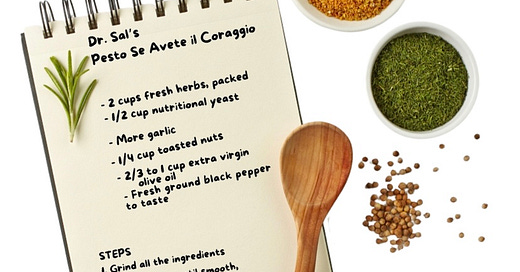Okay. Now we can eat.
Paulie in Goodfellas (Paul Sorvino)
My wife, Marie, and I are pretty good cooks, if I say so myself, but our methodology is radically different. She will find recipes she likes and purchase the ingredients at the store. When cooking, she will follow the recipe although she will frequently make substitutions due to necessity or taste. For instance, she usually doubles the garlic and reduces or eliminates salt. I, on the other hand, prefer to go to the store and buy what appeals to me. Then, when it is time to cook, I pretty much just make it up. As you may have guessed, we rarely cook together.
To be sure, we both can cook both ways. She is as good an improviser as I am, and I can follow a recipe. In fact, I would argue that my improvisatory skills are largely due to my experience with recipes. Needless to say, we eat pretty well although I am sure Marie would do better in the final judgment of a cooking contest. Then again, have you tried my pesto?
Notice that while how we shop and cook (our inputs) is quite different, our outputs (the presentation of the meal itself) is usually objectively good, and the final product can be quite satisfying (our outcomes).
Let’s mess with this culinary bliss a bit. When we were first starting out way back in the 1900s, our meals could be decidedly hit or miss. We had access to pretty much the same ingredients, but we still struggled to make it all work. You can follow a recipe or the directions on the package, but much of the skill of cooking is mastering the subtleties. For instance, I have learned to remove pasta from the boiling water a few minutes before the time indicated on the box because it will continue to cook, and if you smother it in hot gravy (that’s Italian-American for “tomato sauce”) it will cook even more. Plan accordingly, and don’t you dare tell me to rinse the cooked pasta in cold water to keep it from cooking longer! Really. Just don’t.
For years I followed the directions on the box, and, yes, I admit I tried the cold water trick too. I either ended up with mushy, overcooked pasta or with pasta that was slimy and flavorless (because of the cold water rinse if that isn’t clear). At some point, I just started testing the pasta before it was officially done, and realized the thing to do was to drain it when it was still a little too hard. Molto bene!
But what about inputs? Sometimes we cannot get the ingredients we want, or something goes awry. Maybe those greens started turning a little sooner than we anticipated, or that head of cauliflower that got shoved to the back of the fridge is getting spongy gray patches on its surface. Both of us, Marie and I, can readily compensate with substitutions or interventions. For instance, a bunch of kale that has started to yellow is no good in a salad or at the center of a cooked dish, but it could still play a supporting role as an ingredient. Did you know you can grill greens, by the way?
Similarly, sometimes one of Marie’s recipes is a bust, or I just really overplay my hand while improvising. Even then, we can usually compensate and recover the meal. When that fails, we just break out more wine!
Well. That’s it! That’s the essay. No other point to make.
Except maybe a little about inputs, outputs, and outcomes. First some basic definitions. Inputs are the elements that you start with. Outputs are the final product. Outcomes are the quality and use of the product — how it functions out there in the world. This essay consists of words and ideas (inputs). The output is the essay itself. The outcome is how it is received and used. If you learn from it, that is a good outcome.
Ingredients and effort are inputs, I think we can all agree. The quality and type of ingredients along with the effort and degree of skill applied can determine the output, the meal. The outcome, how the meal actually tastes or is received is largely dependent on both although not perfectly so. Have you ever had a meal come out all wrong and yet still be delicious? Maybe you did not have the ingredients you wanted, or the recipe promised more than it could deliver. The food does not look or taste as it should, yet it is satisfying in the end. Go figure.
You can also have all the right inputs and reach the right output, but the meal tastes bland. I know people who cook like this. They buy the best ingredients, use high-end cooking equipment, and work their tails off while following the recipe to the letter. They are so highly skilled that the presentation (the way the food looks when served) is something out of a culinary magazine. Yet, consistently, their meals are blah. Pass the hot sauce, please! Yes, they enjoy their bland diet and, of course, wilt like grilled kale in the presence of my pesto. Still, they seem to input a great deal for clearly mediocre outcomes. Such bland food simply doesn’t require all they put into it.
Say. This wouldn’t happen to sound like anyplace you may have worked? Maybe everything there is about completing forms (inputs) and filing reports (outputs), but the upshot is perpetual mediocrity (outcomes)? Perhaps every intervention there revolves around adding or tweaking forms or producing more reports to no avail. What a waste.
Tweaking the same-old business inputs is like blaming the grocer or the recipe writer if your meals come out the same-old way. Really? Is there anything else you could change?
Perhaps you are thinking, “Jeez, Jim, let go of the food thing! Are you hungry or something as you write this?”
Well, a little now.
Okay, so my point — before I go fix my (delicious) lunch — we often imagine that by controlling the same-old inputs we can perfectly control outputs and therefore outcomes. As I hope my cooking class has demonstrated, inputs can be hugely impactful with regard to outputs and outcomes. Except when they aren’t. The assumption that controlling the same inputs over and over will directly control outputs is a fallacy beloved by perfectionists, micromanagers, small-minded bureaucrats, and other control freaks.
Remember my pasta box rule? When I used to follow the directions perfectly, too often everything seemed great until we actually put the goopy spaghetti into our mouths. Al dente? I think not! More like Al Gore! The pasta we purchased was good. The process was accurate. It looked okay, spaghetti strands not clumping or slimy. What went wrong?
Finally the point, and then we can eat!
Inputs are important. Ingredients, recipes, skill, technique. Maybe you even get an output, a meal, that is precisely what you intended. You can get all that perfectly right and still end up with blah. Sometimes you need to revise or even chuck the old inputs altogether.
There was an Italian restaurant that opened in the small Iowa town I lived in a while back. Good food was pretty hard to find in that town, so I was excited. I even turned a blind eye to obvious flaws. The restaurant had all the right stuff going in, though. The restauranteurs had experience and some skill. The restaurant dining room was very good. The kitchen was more than sufficient. The food looked and smelled good. A deft twirl of the fork and…
Mah.
Dr. Sal’s Pesto Se Ne Hai il Coraggio (Pesto If You Dare)
INGREDIENTS- 2 cups fresh herbs, packed (Basil is traditional, but you can use any herb that is not too overwhelming. Sage, for instance, is too strong on its own. Yet, you can blend herbs, so blending basil and sage works well. I also sometimes make it with one cup of herbs and one cup of greens such as kale or spinach. The greens add a rich dimension to the pesto, but don’t use greens that are old and yellowing.)- 1/2 cup nutritional yeast (Grated parmesan or pecorino or another hard, salty Italian cheese is traditional. My doctor told me to lay off the cheese, so I use nutritional yeast, which I have come to prefer in pesto. If you crave the salt from the cheese, you can add salt. Or just use the cheese. What do I care?)- Garlic (The amount? More. Recipes often call for two cloves. If you don’t use at least double that, you might as well buy that green goop they sell in jars.)- 1/4 cup toasted nuts (Pine nuts are traditional but expensive. Other mild nuts, such as almonds, work great. Someone once told me that sunflower seeds are a cheap and delicious substitute. After trying that out, I agree that sunflower seeds are, indeed, cheap. I wouldn’t use walnuts or anything that bitter although you may dig it. By the way, toasting the nuts does not involve dropping them into a standard toaster!)- Fresh ground black pepper to taste.- For the truly adventurous, add a little fresh hot pepper — like maybe up to half a jalapeño.- 2/3 to 1 cup extra virgin olive oil (Start with a small amount and add more as you go. If it looks dry, add a bit more, but don’t overdue it. You don’t want your pesto to look like the Chicago River on St. Patrick’s Day. Come to think of it, you don’t want your pesto to look like the Chicago River on any day.)STEPS1. Take tradition. Toss it into the breeze.2. Grind all the ingredients except the oil in a blender until smooth, or use a mortar and pestle if you have no sense. As you blend, add oil a little bit at a time as needed (keeping in mind the Chicago River limitation). 3. Spread it on anything except breakfast cereal. Raw. Cooked. It’ll knock you out!4. Did I mention this pesto freezes nicely? You may have to add oil once it defrosts, though.5. If the pesto comes out crumby, don’t blame me. I only wrote the recipe. You own the outcome.Buon appetito!
How often do you consider the distinction among inputs, outputs, and outcomes? Do you ever find yourself focused on inputs when you should be more concerned with outcomes?
You can learn how to stop wasting time and energy and get great outcomes, and I can help. Click below for your free consultation and gift.
Share your thoughts on this topic or participate in a discussion by leaving a comment below or by contacting me directly by email:
You’ll need to register with Substack to leave a comment, which is painless and free.
Please share this post on social media.
And don’t forget to SUBSCRIBE to have On Leading with Greatness sent weekly to your inbox. I look forward to hearing from you.
Intro and outro podcast theme music by LiteSaturation from Pixabay.















Share this post